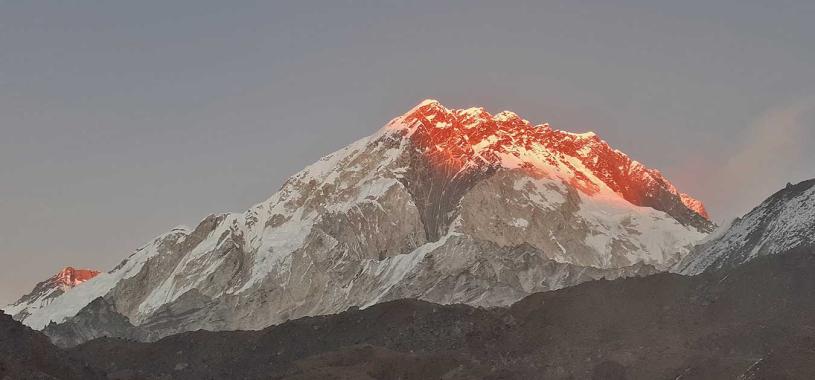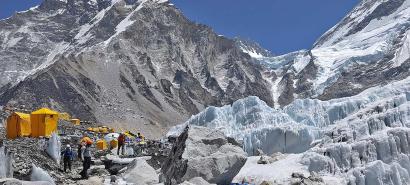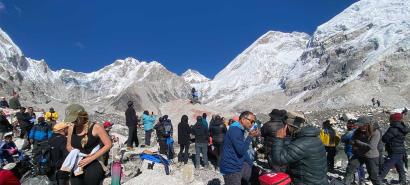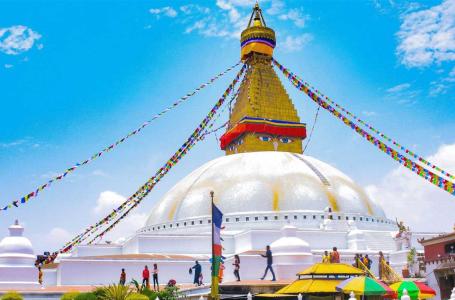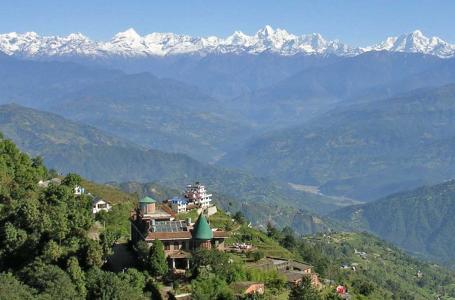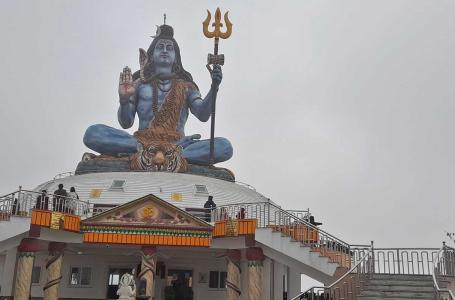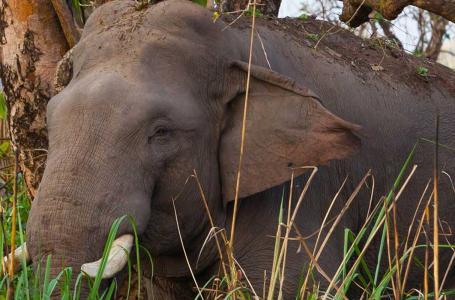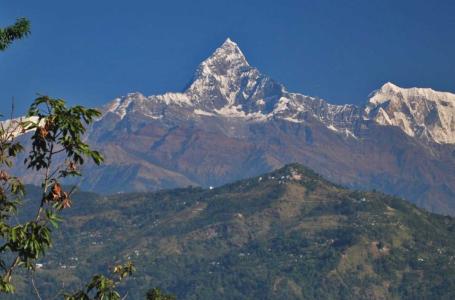- 01 Pax USD 45550 pp
- 02 to 05 Pax USD 41500 pp
- 06 to 10 Pax USD 42350 pp
- 11 to 15 Pax USD 39999 pp
Itinerary
Upon your arrival at Tribhuvan International Airport, our representatives will warmly welcome you and transfer you to your hotel. After check-in, we’ll have a short briefing about the expedition and you will meet the rest of the team. You’ll have time to rest or explore nearby attractions in the heart of Kathmandu.
- Activities: Airport pick-up, expedition briefing, leisure time.
- Accommodation: Hotel in Kathmandu.
This day is reserved for official procedures. We will finalize the required permits for your Everest expedition, including climbing permits and other necessary documentation. You can also take some time to double-check your gear and purchase any last-minute equipment. You may explore cultural heritage sites like Swayambhunath Stupa (Monkey Temple) or Boudhanath Stupa, depending on the time available.
Activities: Official documentation, gear check, and sightseeing.
Accommodation: Hotel in Kathmandu.
Today, you will meet your expedition guides, Sherpas, and other team members. We’ll go over the expedition plan in detail, focusing on safety protocols, acclimatization strategies, and how to use essential equipment like oxygen cylinders and climbing gear. Afterward, you’ll have the rest of the day for any final shopping or resting before the adventure begins.
Activities: Final briefing, gear check, preparation, and resting.
Accommodation: Hotel in Kathmandu.
Early in the morning, we take a short but exhilarating flight to Lukla (2,800m), the gateway to the Everest region. After arriving, we begin trekking through lush forests and traditional Sherpa villages before reaching Phakding.
Trekking Time: 3–4 hours.
Activities: Scenic flight, start of the trek.
Accommodation: Teahouse in Phakding.
Today’s trek takes us through pine forests and along the Dudh Koshi River, crossing several suspension bridges adorned with prayer flags. We enter Sagarmatha National Park at Monjo and continue on a steep ascent to Namche Bazaar, the famous Sherpa town.
Trekking Time: 6–7 hours.
Activities: Trek through forests and suspension bridges, enter Namche Bazaar.
Accommodation: Teahouse in Namche Bazaar.
Acclimatization is crucial, so we spend the day in Namche to allow our bodies to adjust to the altitude. A short hike to the Everest View Hotel offers stunning views of Everest, Lhotse, Ama Dablam, and other peaks. You’ll have the opportunity to visit local museums and explore the vibrant bazaar.
Activities: Acclimatization hike, sightseeing in Namche.
Accommodation: Teahouse in Namche Bazaar.
We continue trekking through dense rhododendron forests and cross the Imja Khola River before reaching the famous Tengboche Monastery. This is one of the most important spiritual centers for the Sherpa people and offers panoramic views of Ama Dablam and Everest.
Trekking Time: 5–6 hours.
Activities: Scenic trek, visit to Tengboche Monastery.
Accommodation: Teahouse in Tengboche.
Today’s trail descends through forests, then climbs past villages like Pangboche before reaching Dingboche. You’ll notice a change in landscape, with fewer trees and more expansive views of the mountains. Dingboche is a beautiful village known for its stone walls that protect the crops from harsh winds.
Trekking Time: 5–6 hours.
Activities: Trek through high-altitude terrain, explore Dingboche.
Accommodation: Teahouse in Dingboche.
Another acclimatization day in Dingboche. We take a hike to Nagarjun Hill to help adjust to the altitude. The hike rewards us with exceptional views of Makalu, Lhotse, and Island Peak. After the hike, we return to Dingboche for rest.
Hiking Time: 4–5 hours.
Activities: Acclimatization hike, enjoy mountain views.
Accommodation: Teahouse in Dingboche.
Today, we leave the main trekking route and head toward Lobuche High Camp. The trek involves steep sections as we ascend into higher altitudes, where the landscape becomes more rugged and remote.
Trekking Time: 5–6 hours.
Activities: Trek to high camp, preparation for Lobuche summit.
Accommodation: Camp at Lobuche High Camp.
Early in the morning, we begin our ascent of Lobuche East. The climb is challenging but rewarding, offering breathtaking views of Everest, Lhotse, and other Himalayan giants. After summiting, we descend to Lobuche for a well-deserved rest.
Climbing Time: 7–8 hours.
Activities: Lobuche summit climb, descend to Lobuche.
Accommodation: Teahouse in Lobuche.
This day is reserved as a contingency day in case of delays due to weather, health issues, or any other unforeseen circumstances.
Activities: Rest or adjust the schedule as needed.
Accommodation: Teahouse in Lobuche.
Today, we trek to Gorakshep, the last settlement before Everest Base Camp. After a short rest, we continue to Everest Base Camp, the staging area for climbers attempting to summit Everest. The base camp is a bustling hub of activity, surrounded by icefalls and towering peaks.
Trekking Time: 6–7 hours.
Activities: Trek to Base Camp, explore surroundings.
Accommodation: Camp at Everest Base Camp.
A rest day at Everest Base Camp to recover from the trek and prepare for the upcoming climbs. This day allows you to acclimatize further and get familiar with the base camp environment.
Activities: Rest and acclimatization.
Accommodation: Camp at Everest Base Camp.
Before beginning the ascent, we perform a traditional Puja Ceremony to seek blessings from the mountain gods for a safe climb. This is a sacred ritual for all climbers in the Himalayas, led by local Sherpas and monks. The rest of the day will be spent training and organizing gear for the climb.
Activities: Puja Ceremony, training practice, rest and preparation.
Accommodation: Camp at Everest Base Camp.
We’ll use this day to practice essential climbing techniques, including fixed rope climbing, ladder crossings over crevasses, and other mountaineering skills that will be critical during the ascent. You will familiarize yourself with high-altitude equipment like crampons and oxygen masks.
Activities: Climbing training and skill practice.
Accommodation: Camp at Everest Base Camp.
Today is dedicated to the final checks and preparations. Sherpas will help organize the gear, and we will review the climbing strategy, safety protocols, and oxygen usage plan. This day is also used for resting and mentally preparing for the challenging days ahead.
Activities: Final preparation, briefing, resting.
Accommodation: Camp at Everest Base Camp.
Our first acclimatization rotation begins as we leave Base Camp and trek through the Khumbu Icefall, a challenging and technical section. The Icefall features towering ice towers and deep crevasses. After navigating this section, we reach Camp 1, our stop for the night.
Climbing Time: 5–6 hours.
Activities: Climb through Khumbu Icefall, reach Camp 1.
Accommodation: Camp at Camp 1.
Today, we climb to Camp 2, located in the Western Cwm, a relatively flat and wide valley. The route is less technical, but altitude presents a significant challenge. Upon reaching Camp 2, we’ll spend the night resting and further acclimatizing.
Climbing Time: 4–5 hours.
Activities: Climb to Camp 2, rest and acclimatize.
Accommodation: Camp at Camp 2.
We spend a full day at Camp 2 to allow our bodies to adjust to the higher altitude. This day is important for recovery, and you can enjoy the stunning views of Everest, Nuptse, and Lhotse while relaxing at camp.
Activities: Rest, acclimatization, enjoy mountain views.
Accommodation: Camp at Camp 2.
Today, we push toward Camp 3, located on the Lhotse Face. This climb involves using fixed ropes to ascend steep and icy terrain. After touching Camp 3 for acclimatization, we descend back to Camp 2 for the night.
Climbing Time: 6–7 hours.
Activities: Climb to Camp 3, and descend to Camp 2.
Accommodation: Camp at Camp 2.
After completing the first acclimatization rotation, we descend all the way back to Everest Base Camp to rest and recover. This descent will allow us to relax and regain energy before the next rotation.
Trekking Time: 4–5 hours.
Activities: Descend to Base Camp, rest.
Accommodation: Camp at Everest Base Camp.
We spend the day resting and recovering at Everest Base Camp. You’ll have time to stretch, enjoy hot meals, and prepare mentally for the final ascent.
Activities: Rest and recovery.
Accommodation: Camp at Everest Base Camp.
After acclimatization rotations, this is an additional rest day at Everest Base Camp. You will recover and wait for the right weather window for the summit push. Sherpas will make final checks on all the equipment and oxygen supplies.
Activities: Rest, final preparations.
Accommodation: Camp at Everest Base Camp.
The summit push begins! We leave Base Camp and climb through the Khumbu Icefall one last time, reaching Camp 2. The route is familiar from the earlier acclimatization rotations, but this time you’ll carry less weight, as most supplies are already at the higher camps.
Climbing Time: 5–6 hours.
Activities: Climb to Camp 2.
Accommodation: Camp at Camp 2.
You’ll rest at Camp 2 to allow your body to adjust before heading toward higher altitudes. This rest day is essential for conserving energy for the more challenging days ahead.
Activities: Rest and acclimatization.
Accommodation: Camp at Camp 2.
Today, we ascend to Camp 3, located on the steep and icy Lhotse Face. The climb is demanding and involves using fixed ropes. This is where we begin to use supplemental oxygen, which will make breathing easier as we gain altitude.
Climbing Time: 6–7 hours.
Activities: Climb to Camp 3, start using oxygen.
Accommodation: Camp at Camp 3.
This day is spent acclimatizing at Camp 3. Climbers will practice using oxygen and ensure that all equipment is functioning properly. Rest is critical to prepare for the next push to Camp 4.
Activities: Rest, acclimatization, and oxygen practice.
Accommodation: Camp at Camp 3.
We continue ascending the Lhotse Face and head toward Camp 4 on the South Col. This camp is the highest before the summit push and is located in a harsh environment. The climb is tough, with thinning air and increasing winds. Upon reaching Camp 4, we rest for a few hours before attempting the summit.
Climbing Time: 6–8 hours.
Activities: Climb to Camp 4.
Accommodation: Camp at Camp 4.
We spend the day resting and preparing for the final summit attempt. Oxygen cylinders are checked, and you will eat light, high-energy meals to stay fueled. Summit night begins late in the evening or early morning, depending on weather conditions.
Activities: Rest, briefing, and preparation.
Accommodation: Camp at Camp 4.
The day you’ve been waiting for! We begin the final ascent to the summit in the early hours of the morning. The route follows the Southeast Ridge, passing through the Balcony, South Summit, and the famous Hillary Step. Upon reaching the summit of Mount Everest, you’ll experience the thrill of standing on top of the world!
After reaching the summit, we begin the descent to Camp 4 on the South Col.
Climbing Time: 10–12 hours round trip (summit and descent to Camp 4).
Activities: Summit Everest and return to Camp 4.
Accommodation: Camp at Camp 4.
After summiting, we continue descending to Camp 2. Descending is often more difficult due to exhaustion, but the lower altitude and increased oxygen levels help with recovery.
Climbing Time: 6–7 hours.
Activities: Descend to Camp 2.
Accommodation: Camp at Camp 2.
We make the final descent back to Everest Base Camp, crossing the Khumbu Icefall one last time. The sense of accomplishment is overwhelming as you complete your expedition.
Trekking Time: 5–6 hours.
Activities: Final descent to Base Camp, celebration at Base Camp.
Accommodation: Camp at Everest Base Camp.
After the summit push, Day 34 is a vital recovery day at Everest Base Camp. Climbers may still be feeling the effects of the high-altitude exertion, so this day focuses on physical rest and recuperation.
Activities: Rest, enjoy a hearty meal, and reflect on the summit success.
Accommodation: Camp at Base Camp.
We take the time to regroup as a team and discuss the summit experience. Sherpas and climbers check all equipment and gear to ensure everything is accounted for, and any remaining supplies are prepared for descent.
Activities: Team debrief, checking equipment and oxygen supplies.
Accommodation: Camp at Base Camp.
For those climbers who were delayed or need extra recovery time, Day 36 is a buffer day for waiting and providing further rest at Base Camp. It’s also a day to prepare for descent.
Activities: Rest, assist remaining climbers, prepare to leave Base Camp.
Accommodation: Camp at Base Camp.
Should the weather window have caused delays, this day will allow the team to rest, monitor forecasts, and be ready for another summit push if necessary. Alternatively, climbers may begin mentally preparing for the descent if no further summit attempts are required.
Activities: Rest and monitor weather forecasts.
Accommodation: Camp at Base Camp.
The team continues to monitor the weather, preparing for a potential second summit attempt if needed. Alternatively, climbers may finalize their plans to descend. Sherpas remain in contact with weather experts to plan the next steps.
Activities: Weather monitoring, rest, or final preparations for descent.
Accommodation: Camp at Base Camp.
This day is kept flexible for any final weather-related delays or as an extra day to rest at Base Camp before making the final trek down. Team members may also assist other climbers or finalize packing gear for the return journey.
Activities: Rest, contingency preparation for summit, or final preparations for descent.
Accommodation: Camp at Base Camp.
Should the initial summit attempt have been unsuccessful due to weather, Day 40 marks the start of another rest period, preparing climbers for a second push. Alternatively, this is a continued rest period for those awaiting the rest of their team at Base Camp.
Activities: Rest, recovery, and prepare for another summit push (if necessary).
Accommodation: Camp at Base Camp.
If the weather permits and climbers are ready for another attempt, the team ascends back to Camp 2. This day mimics the earlier movements during the summit push, but climbers may experience it with a lighter load.
Climbing Time: 5–6 hours.
Activities: Climb to Camp 2.
Accommodation: Camp at Camp 2.
To further adjust and recover, climbers rest at Camp 2. The body is already familiar with the altitude, but the extra day ensures proper acclimatization before climbing higher.
Activities: Rest, acclimatization.
Accommodation: Camp at Camp 2.
The team makes its way to Camp 3, using the previously established fixed ropes along the Lhotse Face. The team will use supplemental oxygen again, as it is necessary for functioning at these altitudes.
Climbing Time: 6–7 hours.
Activities: Climb to Camp 3.
Accommodation: Camp at Camp 3.
The team takes a rest at Camp 3 to ensure they are properly acclimatized and ready for the summit push. Oxygen systems are checked again to ensure they are functioning optimally.
Activities: Rest and acclimatization.
Accommodation: Camp at Camp 3.
Climbers proceed to Camp 4 on the South Col once again. The goal is to get as much rest as possible here before the second summit attempt.
Climbing Time: 6–8 hours.
Activities: Climb to Camp 4, rest for summit push.
Accommodation: Camp at Camp 4.
The second summit attempt takes place if weather conditions allow. Climbers will once again push through the South Summit, Hillary Step, and onward to the summit of Everest. After reaching the summit, climbers will descend back to Camp 4.
Climbing Time: 10–12 hours.
Activities: Summit Everest and return to Camp 4.
Accommodation: Camp at Camp 4.
Following the summit, the team descends back to Camp 2, where the air is thicker, making recovery faster.
Climbing Time: 6–7 hours.
Activities: Descend to Camp 2.
Accommodation: Camp at Camp 2.
The team makes its way back down to Everest Base Camp, concluding the climbing phase of the expedition.
Trekking Time: 5–6 hours.
Activities: Final descent to Base Camp.
Accommodation: Camp at Base Camp.
A well-deserved rest day is enjoyed at Base Camp after the summit success and long descent. Climbers can relax, recover, and celebrate with the team.
Activities: Rest and celebration.
Accommodation: Camp at Base Camp.
Day 50 serves as a buffer day, allowing for flexibility if summit attempts have been delayed due to weather or health conditions. If the team has already completed the summit, this is a day for additional rest and recuperation at Base Camp.
Activities: Either prepare for a delayed summit attempt, rest or celebrate the expedition’s success.
Accommodation: Camp at Base Camp.
The team may use Day 51 for further rest or for additional final preparations if the descent has been delayed for any reason. This day can also be reserved to accommodate any members who may need additional recovery time after the summit.
Activities: Rest, final packing of gear, and equipment checks.
Accommodation: Camp at Base Camp.
On Day 52, the team will begin the process of packing up their equipment at Base Camp and prepare for the trek down the mountain. Sherpas and guides will assist in organizing gear and breaking down the campsites.
Activities: Pack equipment and break down camp.
Accommodation: Camp at Base Camp.
If all preparations are complete, Day 53 will be a rest day for the team to mentally prepare for leaving Everest Base Camp. If needed, the team may also perform any last-minute packing or cleaning of the Base Camp area.
Activities: Rest or final packing.
Accommodation: Camp at Base Camp.
Day 54 serves as the final buffer day for any remaining activities at Base Camp. If the team is fully prepared and the weather allows, this day marks the beginning of the trek down from Base Camp toward Pheriche.
Activities: Rest or begin descent.
Accommodation: Camp or lodge depending on the location.
After a successful summit and descent, we begin the trek down from Everest Base Camp toward lower altitudes. Our destination is Pheriche, a small settlement with a pleasant environment for recovery.
Trekking Time: 6–7 hours.
Activities: Trek downhill, recover at Pheriche.
Accommodation: Teahouse in Pheriche.
We continue descending through the valley, passing by lush forests and suspension bridges. By the end of the day, we will reach Namche Bazaar, where you can celebrate your successful expedition with the team.
Trekking Time: 6–7 hours.
Activities: Trek to Namche Bazaar, rest and celebrate.
Accommodation: Teahouse in Namche Bazaar.
This is the final day of trekking as we return to Lukla. The trail is mostly downhill, and you can enjoy the final views of the Himalayan landscape before the journey ends.
Trekking Time: 6–7 hours.
Activities: Final day of trekking, return to Lukla.
Accommodation: Teahouse in Lukla.
We take an early morning flight back to Kathmandu, leaving behind the mountains and arriving back in the city. Upon arrival, you’ll be transferred to your hotel for some well-earned rest.
Activities: Flight to Kathmandu, relax and recover.
Accommodation: Hotel in Kathmandu.
You’ll have a day to relax, shop for souvenirs, or explore more of Kathmandu’s cultural sites. In the evening, we’ll have a farewell dinner to celebrate the completion of the expedition.
Activities: Rest, sightseeing, farewell dinner.
Accommodation: Hotel in Kathmandu.
Our team will transfer you to Tribhuvan International Airport for your final departure. We hope you leave with incredible memories of your Everest expedition and a deep connection to the Himalayas.
Activities: Airport drop-off, farewell.
Overview
Everest Expedition: Overview
Mount Everest, the world's highest peak at an astonishing 29,032 feet (8,848.86 meters), has long been a magnet for adventurers and mountaineers. Climbing this majestic giant is a lifelong dream for many. The challenge of standing atop the world's tallest mountain, which straddles the border between Nepal and Tibet, is one of the most thrilling and rewarding experiences imaginable. The first successful ascent of Everest was made on May 29, 1953, by the legendary Sir Edmund Hillary of New Zealand and Tenzing Norgay, a Sherpa from Nepal. They reached the summit via the Southeast Ridge, a route now famously known as the Normal Route. Today, this path remains the most popular way to the top.
Our Everest expedition is designed to follow the traditional route, beginning with a carefully planned acclimatization trek to Everest Base Camp (5,364 meters/17,559 feet). Each climber will be provided with a private tent at the base camp for maximum comfort during their stay. To further acclimatize, we will undertake a summit climb of Lobuche Peak (6,119 meters/20,075 feet), a thrilling adventure in itself. This climb prepares your body for the extreme conditions that lie ahead on Everest.
As we ascend Everest, our team will set up a series of camps at higher altitudes, using robust, four-season tents that accommodate two to three climbers. This camp structure allows us to strategically stock supplies and equipment along the route. Our skilled guides and Sherpas will fix ropes and establish camps, ensuring the safest and most efficient ascent possible. Oxygen will be provided above Camp III (7,300 meters/23,700 feet) to aid climbers as they push towards the summit. With expert leadership, superior equipment, and carefully coordinated logistics, our team is dedicated to providing every participant with the best possible chance of successfully summiting Mount Everest.
About Mount Everest
Mount Everest is not only the tallest mountain on Earth but also one of the most significant icons in the world of mountaineering. Formed around 50 to 60 million years ago, Everest is a product of the collision between the Indian and Eurasian tectonic plates. This geological process also gave rise to the greater Himalayan mountain range, home to some of the highest peaks on the planet.
Historical Context
- Naming: The mountain was named after Sir George Everest, the Surveyor General of India, in 1865. Prior to this, Everest was known as Peak XV, and its height was first recorded as the tallest peak in 1856.
- Previous Titleholder: Before Everest was identified as the highest mountain, Kangchenjunga held the title as the tallest peak.
Geographic Location
Mount Everest is positioned on the border between Nepal and Tibet, with its summit located in Nepal. The peak holds cultural and spiritual significance for both nations, reflected in its local names:
- In Tibet: The mountain is called Qomolangma, meaning "Holy Mother."
- In Nepal: It is known as Sagarmatha, which translates to "Head in the Great Blue Sky."
Height Measurements
The height of Mount Everest has been measured and revised several times over the years:
In 1856, it was recorded at 8,840 meters (29,002 feet).
An Indian survey in 1955 adjusted the height to 8,848 meters (29,029 feet).
The most recent joint survey by China and Nepal in 2022 confirmed the height as 8,848.86 meters (29,031.69 feet), the most accurate measurement to date.
Geological Insights
Mount Everest continues to rise, albeit slowly, due to the ongoing tectonic activity between the Indian and Eurasian plates. The mountain is currently rising at a rate of approximately 40 centimeters per century. This geological activity not only affects Everest but also contributes to the overall elevation changes in the Himalayas, making it a dynamic and ever-evolving natural wonder.
How Long Does It Take to Climb Mount Everest?
Climbing Mount Everest is a monumental feat that requires significant time for preparation and acclimatization. On average, a complete Everest expedition lasts around 60 days. This period includes time spent in Kathmandu, preparation at Everest Base Camp, and the actual summit attempt. The most important part of the expedition is the acclimatization phase, which typically lasts around 30 to 40 days. During this time, climbers gradually adjust to the thin air and altitude, allowing their bodies to cope with the extreme conditions. Acclimatization includes multiple rotations between Base Camp and higher camps.
As climbers progress to Camp I (5,900 meters/19,500 feet), Camp II (6,400 meters/21,000 feet), and Camp III (7,300 meters/23,700 feet), the challenges increase due to thinning air and colder temperatures. Proper acclimatization and physical stamina are crucial to success, and our experienced Sherpas provide guidance and support throughout the ascent.
Tentative Acclimatization Schedule
Here’s a typical acclimatization schedule that allows climbers to adjust to the extreme altitudes:
First Rotation (April 21-23):
- Climb Lobuche East Peak (6,119 meters/20,075 feet) for acclimatization.
Second Rotation (April 27 - May 03):
- Climb to Camp I (5,900 meters/19,500 feet).
- Climb to Camp II (6,400 meters/21,000 feet).
- Rest at Camp II.
- Touch Camp III (7,300 meters/23,700 feet), then descend and sleep at Camp II.
- Return to Base Camp (5,364 meters/17,559 feet) for rest.
Summit Push (Weather Permitting: May 08-20)
- Climb to Camp II (6,400 meters/21,000 feet).
- Climb to Camp III with the use of oxygen (7,300 meters/23,700 feet).
- Climb to Camp IV South Col with the use of oxygen (7,900 meters/25,912 feet).
- Summit push (8,848.86 meters/29,031 feet) and descent to Camp IV.
Descend to Camp II. - Final descent to Base Camp.
Important Note on Acclimatization
Each climber responds to altitude differently, and the acclimatization program may be adjusted during the expedition to suit individual needs. Our experienced guides monitor every climber closely to ensure they are adapting well to the conditions.
Highlights
- Summiting Mt Everest - the highest mountain on earth.
- Scenic flight to Lukla
- Breathtaking view of the sunset over Mt. Everest from the Kalapathar.
- Prayer wheels, colorful flags, mani stones, high suspension bridges.
- Wide range of flora and fauna.
- Ancient monastery in Tengboche (3,867m / 12,687ft)
- One of the world’s highest airports at Syangboche (3,780m / 12.402ft)
- Views of some of the highest peaks, including Mt. Lhotse (8,516m), Cho Oyu (8,201m), and Mt. Makalu (8,463m)
- Explore Sagarmatha National Park
- Khumjung monastery is believed to house a yeti scalp.
- Wildlife like musk deer, colorful pheasants, snow leopard, and Himalayan tahr
- Highest glacier on Earth- The Khumbu Glacier (4,900m)
Cost Details
- Permits & Fees
Everest Climbing Permit: Issued by the Nepal Government (around $11,000 per person).
Sagarmatha National Park Entry Permit.
Khumbu Pasang Lhamu Rural Municipality Fee.
Liaison Officer Fee: Government-appointed officer overseeing the expedition. - Logistics & Transportation
Domestic Flights: Round-trip Kathmandu–Lukla flights.
Airport Transfers: Pick-up and drop-off in Kathmandu.
Cargo & Freight Handling: Transport of expedition gear to Base Camp. - Accommodation & Food
Kathmandu Hotel Stay: Typically 5 nights in a luxury hotel.
Teahouse Accommodation: During trek to Everest Base Camp (EBC).
Base Camp Services: Fully serviced tented accommodation with meals.
High-Altitude Food: Meals and hot drinks at Camps 1, 2, 3, and 4. - Expedition Staff & Support
Experienced Climbing Sherpa: Personal guide for summit push.
Expedition Leader: Certified and highly experienced.
Base Camp Manager & Cook: Ensuring smooth operation.
Porters/Yaks: Carry equipment and supplies to Base Camp. - Equipment & Safety Gear.
Fixed Ropes, Ladders, and Ice Screws: Installed for safer ascent.
Tents & Sleeping Bags: High-altitude expedition tents, foam mattresses.
Oxygen Bottles & Mask-Regulator Set: Essential for the summit push.
Medical Kit & Gamow Bag: Portable hyperbaric chamber for emergencies. - Training & Communication
Pre-Climb Training Sessions: Icefall climbing techniques, rope fixing.
Satellite Phone & Walkie-Talkies: For communication at high altitudes.
Weather Forecast Service: Regular updates for safe summit planning.
- International flights to/from Nepal
- Personal climbing gear (boots, crampons, down suit, etc.)
- Travel insurance (must cover high-altitude evacuation)
- Personal expenses (laundry, internet, charging devices)
- Tips for guides, Sherpas, and staff
Equipment List
Clothing & Layering System
🔹 Base Layers (Moisture-wicking & Warmth)
Thermal underwear (top & bottom) – Merino wool or synthetic
Lightweight & midweight base layers
🔹 Insulation Layers (Heat Retention)
Fleece or softshell jacket
Heavy down jacket (800-fill or higher)
Down pants for extreme cold
🔹 Outer Shell (Wind & Waterproof Protection)
GORE-TEX® shell jacket (windproof, waterproof, breathable)
GORE-TEX® shell pants (full-zip for easy wear)
🔹 Gloves & Mittens
Lightweight liner gloves (fleece or wool)
Insulated gloves (for moderate cold)
Down mittens (for summit push)
🔹 Head & Face Protection
Balaclava & neck gaiter (protection from wind and frostbite)
Warm beanie or wool hat
Glacier sunglasses (UV400 protection)
Ski goggles (for high-altitude wind & snow)
Footwear
🔹 Mountaineering Boots
Double-layer mountaineering boots (Scarpa Phantom 8000, La Sportiva Olympus Mons)
🔹 Gaiters
High-altitude gaiters (to keep snow out of boots)
🔹 Socks
Thin liner socks (moisture-wicking)
Heavy wool socks (for warmth)
Spare pairs (to keep dry)
Climbing Gear
🔹 Technical Equipment
Ice axe (for steep sections)
Crampons (12-point, compatible with mountaineering boots)
Harness (lightweight, adjustable)
Carabiners (locking & non-locking)
Ascender (Jumar)
Belay/rappel device
Prusik cords (for self-rescue)
Trekking poles (adjustable)
Camping & Sleeping Gear
🔹 Tents & Shelter
High-altitude expedition tent (windproof, strong for extreme cold)
🔹 Sleeping Gear
Sleeping bag (-40°C/-40°F, down-filled)
Inflatable sleeping pad (for insulation)
Foam mat (extra insulation)
Oxygen & Safety Gear
🔹 Oxygen System
Bottled oxygen (at least 3-4 cylinders for summit bid)
Oxygen mask & regulator (TopOut or Summit Oxygen system)
🔹 Safety & Communication
Satellite phone (Iridium or Thuraya)
Walkie-talkie (for team communication)
GPS device & altimeter watch
Headlamp (extra batteries)
First aid kit (personal medications, blister care, altitude sickness meds)
Gamow bag (portable hyperbaric chamber for emergencies)
Food & Hydration
🔹 Hydration System
Insulated water bottles (Nalgene or thermos)
Camelbak or hydration bladder (for lower altitude)
Water purification tablets
🔹 Food & Snacks
Energy bars & gels
Dried fruits & nuts
Freeze-dried meals (for high-altitude camps)
FAQs
The two primary routes to the summit are the South Col Route (via Nepal) and the North Col Route (via Tibet). The South Col Route is the most popular, offering better rescue options and a more established route.
A full Everest expedition takes around 6–8 weeks, including acclimatization, rotations between camps, and waiting for a proper summit window.
Climbers face extreme altitude sickness, unpredictable weather, technical ice and rock sections, and physical exhaustion, especially in the death zone (above 8,000m).
The expedition follows a gradual acclimatization schedule, with rotations between Base Camp (5,364m) and higher camps before the final summit push from Camp 4 (8,000m).
The thin air above 8,000m has only one-third of the oxygen available at sea level, making supplemental oxygen crucial for survival and reducing the risk of altitude sickness, frostbite, and exhaustion.


